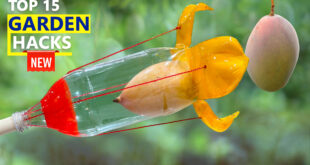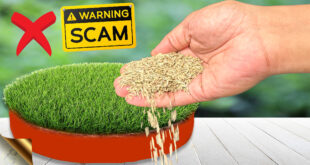WHAT IS GRAFTING?
Grafting also known as graftage, is a horticultural technique whereby tissues of plants are joined together so that they continue their growth together. The upper part of the combined plant is called the ‘scion’while the lower part is called the ‘rootstock’.
The grafting technique is most commonly used in asexual propagation of commercially grown plants for the horticultural and agricultural Business.
In most cases, one plant is selected for its roots and this is called the stock or rootstock. The other plant is selected for its stems, leaves, flowers, or fruits and is called the scion or cion. The scion contains the desired genes to be duplicated in future production by the stock/scion plant.
Before Proceed Consider these few scenarios:
- Have you ever come across one of those ‘miracle’ trees? Like – an apple tree that produces six different kinds of apples, or a tree that grows plums, peaches and other fruits, all on the same Stem.
- Talking about another Scenario – like, — You buy an orange tree that has the strong roots of one variety, but the delicious fruit of another variety. What will you think. Wont you think about a method which can combine these two into one?
For generations farmers, botanists, and home gardeners have been using plant biology to make these ideas into reality through a technique called Grafting – which is today’s topic.
Grafting techniques and advantages and Concept:
The Concept of Grafting:
Firstly, You need to know a few parts of the plant. We are familiar with the outer layer of plants – in trees, we know this as bark. However, there is a much more interesting layer of tissue just beneath that bark layer, known as the cambium.
This layer, that’s cambium, is undifferentiated, meaning that the tissue in it doesn’t have any particular job yet – it’s just waiting to be told what to do. This means that it can turn into anything the plant needs: more bark, new vascular tissue, new branches, even some roots. Grafting takes advantage of this undifferentiated tissue layer by exposing it and giving it an idea of what to do. The Vascular Tissues refer to Xylem and Phloem – the Water and Food tubes of a plant. We will not go into details of these now.
Coming to Another Scenario:
One common example of grafting is used in Avocado or The Butter Fruit Plant. I have this plant with me, you can see this plant. Infact, this was grown from a seed.
If you’ve ever tried to grow an avocado tree from an avocado seed, you know that the resulting tree isn’t very strong. This is because the avocado trees that produce the best fruit don’t have the best support system. They put all of their energy into producing tasty fruit part, so they don’t have a lot of energy left over for things like strong roots, or good defenses. This is why avocados are so expensive.
There’s a certain breed of avocado that produces a really strong tree, but not very good fruit. The tree can live in many different kinds of soil, and the roots defend themselves from diseases, but no one wanted to grow this tree because the avocados were not very tasty. Thanks to grafting, it is now common practice to take the scion from one tree and graft it onto the rootstock of the other, producing a new tree with strong roots and delicious fruit. WOW! What an Idea? All this thanks to grafting!
Various Grafting Methods
Grafting is a pretty easy thing to accomplish. There are several types of grafting that you can choose from, depending on what you want to accomplish.
In approach grafting, two fully formed plants are attached together at their stems, leaving the leaves above and the roots below intact without completely cutting anything on both plants. A small part on the side of each stem is stripped of bark, and the newly exposed tissue is pressed together. The stems are tied together to allow time for the tissue to heal over, kind of like forming a scab over a cut or wound in medical practice. Well, This plant ‘scab’ will bind the two stems together permanently.
T budding is a technique in which the scion is reduced to a single bud instead of a whole branch. The bud is removed from its original plant along with a small portion of bark and underlying tissue. It is then nestled into a cut made into the rootstock’s stem, and tied in place. After the graft has healed over, the stem of the rootstock above the newly grafted bud is removed, and the bud will grow.
Cleft grafting is one of the most common techniques, and yields strong grafts. In this type of graft, the rootstock is often larger than the scion. A split or cleft is made in the rootstock, which is wedged open.
The scion is stripped of its bark at one end, and the stripped end is sliced into a sharp angle. This angled scion is then placed into the rootstock cleft and bound up until the graft heals. It is possible to graft more than one scion to a single rootstock in this manner, and is the preferred method for grafting fruit trees.
There are many other specialized techniques for grafting, but the basic method is the same: expose the cambium and encourage it to form new vascular tissue. The more cambium exposed, the stronger the graft, and the more likely your new plant parts will live.
Factors for Successful Graft
- Compatibility of Scion and Stock: Because grafting involves the joining of vascular tissues between the scion and rootstock, plants lacking vascular cambium cannot be normally grafted. As a general rule, the closer two plants are genetically, the more likely the graft union will be successful.
- Cambium Alignment & Pressure: The vascular cambium of the scion and stock should be tightly pressed together and oriented in the direction of normal growth. Proper alignment and pressure encourages the tissues to join quickly, allowing nutrients and water to transfer from the stockroot to the scion.
- Proper Care of Graft Site is must: After grafting, it is important to nurse the grafted plant back to health for a period of time. Various grafting tapes and waxes are used to protect the scion and stock from excessive water loss. Furthermore, depending on the type of graft, twine or string is used to add structural support to the grafting site. Sometimes it is necessary to prune the site, as the rootstock may produce shoots that inhibit the growth of the scion.
Grafting Tools
- Grafting knives or Cutting Tools used have to be really sharp to minimize tissue damage and clean from dirt and other substances to avoid the spread of disease. A good knife for general grafting should have a blade and handle length of about 3 inches and 4 inches respectively.
- Graft Seals: Keeps the grafting site hydrated. Good seals should be tight enough to retain moisture while, at the same time, loose enough to accommodate plant growth. This includes specialized types of clays, waxes, petroleum jelly, and adhesive tapes.
- Other tools like Tying and Support Materials
- Grafting Machines are sometimes useful for Automation, Because grafting can take a lot of time and skill, grafting machines have been created.
Please Share this Article by clicking on the social share icons below.
Well, there s lot more about Grafting. We will not go into the depth. Also Watch this Video Below to understand better.
 GKVKs – Gardening Tips and Store Gardening Tips and Store
GKVKs – Gardening Tips and Store Gardening Tips and Store



